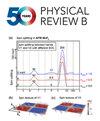Origin of the anomalous Hall effect in Cr-doped RuO2
IF 3.7
2区 物理与天体物理
Q1 Physics and Astronomy
引用次数: 0
Abstract
RuO2 is one of the most highlighted candidates for altermagnetism. However, the most recent muon spin spectroscopy and neutron studies demonstrated the absence of magnetic order in this system. The electronic structure of掺铬RuO2中异常霍尔效应的起源
RuO2是最突出的候选电磁材料之一。然而,最近的μ子自旋光谱和中子研究表明,该系统中缺乏磁序。RuO2的电子结构暗示了空穴掺杂后实现磁有序态的可能性,在cr掺杂的RuO2中实验探索了这种可能性,表明该体系由于变磁而表现出反常霍尔效应(AHE)。本文在密度泛函计算的基础上,对该系统的结果进行了修正,并对实验结果提出了不同的解释。我们的计算表明,额外的空穴与Cr杂质结合,而不掺杂Ru带,Ru带仍然是非磁性的。因此,观察到的AHE不是由变磁引起的,而是完全由磁性铬离子引起的。2025年由美国物理学会出版
本文章由计算机程序翻译,如有差异,请以英文原文为准。
求助全文
约1分钟内获得全文
求助全文
来源期刊

Physical Review B
物理-物理:凝聚态物理
CiteScore
6.70
自引率
32.40%
发文量
0
审稿时长
3.0 months
期刊介绍:
Physical Review B (PRB) is the world’s largest dedicated physics journal, publishing approximately 100 new, high-quality papers each week. The most highly cited journal in condensed matter physics, PRB provides outstanding depth and breadth of coverage, combined with unrivaled context and background for ongoing research by scientists worldwide.
PRB covers the full range of condensed matter, materials physics, and related subfields, including:
-Structure and phase transitions
-Ferroelectrics and multiferroics
-Disordered systems and alloys
-Magnetism
-Superconductivity
-Electronic structure, photonics, and metamaterials
-Semiconductors and mesoscopic systems
-Surfaces, nanoscience, and two-dimensional materials
-Topological states of matter
 求助内容:
求助内容: 应助结果提醒方式:
应助结果提醒方式:


